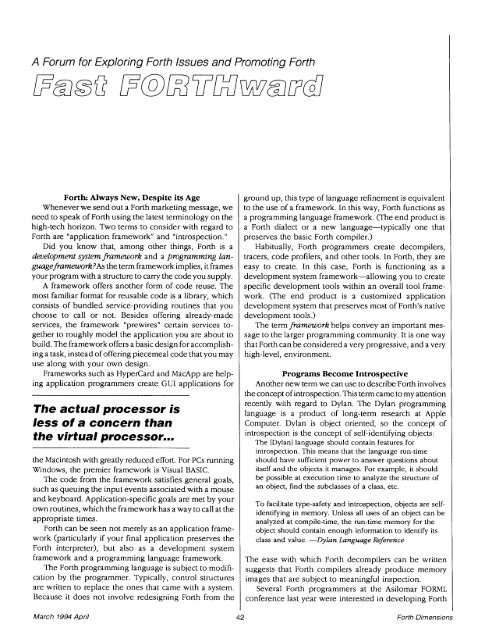FAST Forth Native-Language Embedded Computers
FAST Forth Native-Language Embedded Computers
FAST Forth Native-Language Embedded Computers
Create successful ePaper yourself
Turn your PDF publications into a flip-book with our unique Google optimized e-Paper software.
A Forum for Exploring <strong>Forth</strong> Issues and Promoting <strong>Forth</strong><br />
<strong>Forth</strong>: Always New, Despite its Age<br />
Whenever we send out a <strong>Forth</strong> marketing message, we<br />
need to speak of <strong>Forth</strong> using the latest terminology on the<br />
high-tech horizon. Two terms to consider with regard to<br />
<strong>Forth</strong> are "application framework" and "introspection."<br />
Did you know that, among other things, <strong>Forth</strong> is a<br />
deuelopment system framework and a programming lan-<br />
guage framework?As the term framework implies, it frames<br />
your program with a structure to carry the code you supply.<br />
A framework offers another form of code reuse. The<br />
most familiar format for reusable code is a library, which<br />
consists of bundled service-providing routines that you<br />
choose to call or not. Besides offering already-made<br />
services, the framework "prewires" certain services to-<br />
gether to roughly model the application you are about to<br />
build. The framework offers a basic design for accomplish-<br />
ing a task, instead of offering piecemeal code that you may<br />
use along with your own design.<br />
Frameworks such as Hypercard and MacApp are help-<br />
ing application programmers create GUI applications for<br />
The actual processor is<br />
less of a concern than<br />
the virtual processor...<br />
the Macintosh with greatly reduced effort. For PCs running<br />
Windows, the premier framework is Visual BASIC.<br />
The code from the framework satisfies general goals,<br />
such as queuing the input events associated with a mouse<br />
and keyboard. ~~~lication-specific goals are met by your<br />
own routines, which the framework has a way to call at the<br />
appropriate times.<br />
<strong>Forth</strong> can be seen not merely as an application framework<br />
(particularly if your final application preserves the<br />
<strong>Forth</strong> interpreter), but also as a development system<br />
framework and a programming language framework.<br />
The <strong>Forth</strong> programming language is subject to modification<br />
by the programmer. Typically, control structures<br />
are written to replace the ones that came with a system.<br />
Because it does not involve redesigning <strong>Forth</strong> from the<br />
ground up, this type of language refinement is equivalent<br />
to the use of a framework. In this way, <strong>Forth</strong> functions as<br />
a programming language framework. (The end product is<br />
a <strong>Forth</strong> dialect or a new language-typically one that<br />
preserves the basic <strong>Forth</strong> compiler.)<br />
Habitually, <strong>Forth</strong> programmers create decompilers,<br />
tracers, code profilers, and other tools. In <strong>Forth</strong>, they are<br />
easy to create. In this case, <strong>Forth</strong> is functioning as a<br />
development system framework-allowing you to create<br />
specific development tools within an overall tool frame-<br />
work. (The end product is a customized application<br />
development system that preserves most of <strong>Forth</strong>'s native<br />
development tools.)<br />
The term framework helps convey an important mes-<br />
sage to the larger programming community. It is one way<br />
that <strong>Forth</strong> can be considered a very progressive, and a very<br />
high-level, environment.<br />
Programs Become Introspective<br />
Another new term we can use to describe <strong>Forth</strong> involves<br />
the concept of introspection. This term came to my attention<br />
recently with regard to Dylan. The Dylan programming<br />
language is a product of long-term research at Apple<br />
Computer. Dylan is object oriented, so the concept of<br />
introspection is the concept of self-identifying objects:<br />
The [Dylan] language should contain features for<br />
introspection. This means that the language run-time<br />
should have sufficient power to answer questions about<br />
itself and the objects it manages. For example, it should<br />
be possible at execution time to analyze the structure of<br />
an object, find the subclasses of a class, etc.<br />
To facilitate type-safety and introspection, objects are self-<br />
identifjring in memory. Unless all uses of an object can be<br />
analyzed at compile-time, the run-time memory for the<br />
object should contain enough information to identify its<br />
class and value. --&Ian <strong>Language</strong> Reference<br />
The ease with which <strong>Forth</strong> decompilers can be written<br />
suggests that <strong>Forth</strong> compilers already produce memory<br />
images that are subject to meaningful inspection.<br />
Several <strong>Forth</strong> programmers at the Asilomar FORML<br />
conference last year were interested in developing <strong>Forth</strong><br />
March 1994 April 42 <strong>Forth</strong> Dimensions
















